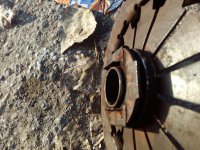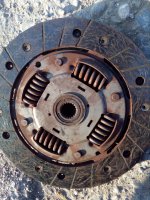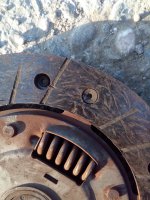Most likely the bend would have been introduced by the clutch being so heavy to operate so the bend would mean that the slave cylinder piston resting position would be further down the bore than it would be with an arm which was not bent. I would guess that with a new clutch this will have little effect but as the friction lining wears, depending on the amount of bend in the arm, problems with "freeing" may occur.
What I mean by this is that if you think about the diaphragm position with a new driven plate fitted - so new friction linings - the diaphragm will be pretty much flat when the cover assembly is tightened down to the flywheel. The release bearing, when at rest, is therefore going to be quite far down the gearbox guide tube (so further away from the gearbox if you like) which will in turn mean the release arm outside the bell housing will be pushing the slave cylinder piston well into the slave cylinder bore. As the friction lining wears the diaphragm very slowly assumes a more dished shape to compensate for the lining material which has worn away (one of the reasons why a worn clutch often feels heavier to operate). The resting position of the release bearing is, of course, dictated by the diaphragm shape - the more dished the diaphragm the nearer the gearbox it's resting position will be and the further down the bore of the slave cylinder will the slave piston resting position be.
So how will a bent (or well worn) release fork/arm affect this? Quite simply it means that for any given position of the diaphragm the slave piston will be further down the slave cylinder bore than the designer intended. If the wear/bend in the arm is slight it's unlikely to have any effect noticeable by the driver. If the wear/bend is extreme then the clutch may work reasonably well with a new friction plate fitted - it may feel a little "stiffer" due to the release arm leverage angle being suboptimal - but as the lining wears a position could be reached where the piston in the slave will reach the end of it's designed limit of travel. In this case it may hit a limiting stop and be unable to move any further or it may simply "pop" out of the end of the bore of the slave cylinder. The result of this is pretty obvious.
Just to complicate things further some clutch systems, because of the leverage system used and the positioning of the slave cylinder, push the slave piston further into the slave cylinder bore as the lining material wears away (think concentric cylinders in particular or earlier RWD setups which were pivoted on the oposite side to the slave cylinder - ie, slave then release bearing with the pivot on the other side of the arm.) but our release arms are pivoted between the slave and the release bearing so they let the piston come out more as the lining wears.
I hope that was useful? If that last bit confuses you just ignore it as it's not really relevant to our wee Fiats but I thought I'd throw it in just in case some knowledgeable person was thinking "Yes, but"
 IMG_20201111_143337.jpg3.3 MB · Views: 91
IMG_20201111_143337.jpg3.3 MB · Views: 91 IMG_20201111_143347.jpg3.5 MB · Views: 50
IMG_20201111_143347.jpg3.5 MB · Views: 50 IMG_20201111_143432.jpg3.1 MB · Views: 41
IMG_20201111_143432.jpg3.1 MB · Views: 41 IMG_20201111_143517.jpg3.5 MB · Views: 51
IMG_20201111_143517.jpg3.5 MB · Views: 51 IMG_20201111_143527.jpg3.2 MB · Views: 38
IMG_20201111_143527.jpg3.2 MB · Views: 38 IMG_20201111_143530.jpg3.4 MB · Views: 39
IMG_20201111_143530.jpg3.4 MB · Views: 39 IMG_20201111_143553.jpg3.7 MB · Views: 53
IMG_20201111_143553.jpg3.7 MB · Views: 53 IMG_20201111_143556.jpg3.3 MB · Views: 45
IMG_20201111_143556.jpg3.3 MB · Views: 45
